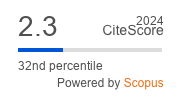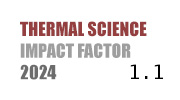THERMAL SCIENCE
International Scientific Journal
THE PSO/GA/ANN MODELING AND PREDICTION FOR THE HIGHER HEATING VALUES OF SOLID FUELS: THE MACHINE LEARNING APPROACH
ABSTRACT
The quick evaluation for the higher heating value (HHV) is crucial for thermo-chemical conversion of solid fuels. In this work, machine learning method based on artificial neural networks (ANN) was used to predict the HHV of solid fuel. The 205 groups of different kinds of solid fuels collected from publications were used. The proximate analysis, ultimate analysis and the combination of two were used as input parameters. The influence of activation function, neuron number, and hid-den layer number on the prediction performance was studied. Results show that single hidden layer with logsig function using eight neurons was an optimized condition for HHV prediction. The combination of two composition analyses could achieve much higher accuracy, with the average relative error of 2.57%. Impact analysis indicated that the non-combustible components, namely ash content and oxygen content showed the largest influencing weight for HHV prediction, ac-counting for 21.73% and 22.91%, respectively. Particle swarm optimization (PSO) and genetic algorithm (GA) were further used to optimize the ANN model. Results show that PSO and GA both improved the prediction performance of ANN model by optimizing the initial weight and threshold values. The average relative errors for PSO-ANN and GA-ANN decreased to 1.15 % and 1.72 %, respectively.
KEYWORDS
PAPER SUBMITTED: 2024-09-22
PAPER REVISED: 2024-12-23
PAPER ACCEPTED: 2025-01-09
PUBLISHED ONLINE: 2025-02-16
THERMAL SCIENCE YEAR
2025, VOLUME
29, ISSUE
Issue 4, PAGES [2881 - 2897]
- Adeleke, O., et al., Prediction of the Heating Value of Municipal Solid Waste: A Case Study of the City of Johannesburg, International Journal of Ambient Energy, 43 (2022), 1, pp. 3845-3856
- Dashti, A., et al., Review of Higher Heating Value of Municipal Solid Waste Based on Analysis and Smart Modelling, Renewable and Sustainable Energy Reviews, 151 (2021), 111591
- Liu, J.-I., et al., Modeling the Energy Content of Municipal Solid Waste Using Multiple Regression Analysis, Journal of the Air & Waste Management Association, 46 (1996), 7, pp. 650-656
- Garcia, R., et al., Spanish Biofuels Heating Value Estimation. Part I: Ultimate Analysis Data, Fuel, 117 (2014), Part B, pp. 1130-1138
- Mason, D. M., Gandhi, K. N., Formulas for Calculating the Calorific Value of Coal and Coal Chars: Development, Tests, and Uses, Fuel Processing Technology, 7 (1983), 1, pp. 11-22
- Mott, R. A., Spooner, C. E., The Calorific Value of Carbon in Coal: The Dulong Relationship, Fuel, 19 (1940), 226-231, pp. 242-251
- Pizarro, C., et al., Spanish Biofuels Heating Value Estimation. Part II: Proximate Analysis Data, Fuel, 117 (2014), Part B, pp. 1139-1147
- Huang, Y.-F., Lo, S.-L., Predicting Heating Value of Lignocellulosic Biomass Based on Elemental Analysis, Energy, 191 (2020), 116501
- Bagheri, M., et al., A Comparative Data Mining Approach for the Prediction of Energy Recovery Potential from Various Municipal Solid Waste, Renewable and Sustainable Energy Reviews, 116 (2019), 109423
- Meraz, L., et al., A Thermochemical Concept-Based Equation to Estimate Waste Combustion Enthalpy from Elemental Composition, Fuel, 82 (2003), 12, pp. 1499-1507
- Shi, H., et al., Characterization, Thermochemical Conversion Studies, and Heating Value Modeling of Municipal Solid Waste, Waste management, 48 (2016), Feb., pp. 34-47
- Kathiravale, S., et al., Modeling the Heating Value of Municipal Solid Waste, Fuel, 82 (2003), 9, pp. 1119-1125
- Tan, P., et al., Estimation of Higher Heating Value of Coal Based on Proximate Analysis Using Support Vector Regression, Fuel Processing Technology, 138 (2015), Oct., pp. 298-304
- Lin, C.-J., et al., Swift Model for a Lower Heating Value Prediction Based on Wet-Based Physical Components of Municipal Solid Waste, Waste management, 33 (2013), 2, pp. 268-276
- Taki, M., Rohani, A., Machine Learning Models for Prediction the Higher Heating Value (HHV) of Municipal Solid Waste (MSW) for Waste-to-Energy Evaluation, Case Studies in Thermal Engineering, 31 (2022), 101823
- Gulec, F., et al., Predictability of Higher Heating Value of Biomass Feedstocks via Proximate and Ultimate Analyses - A Comprehensive Study of Artificial Neural Network Applications, Fuel, 320 (2022), 123944
- Mondal, C., et al., Analysis and Significance of Prediction Models for Higher Heating Value of Coal: An Updated Review, Journal of Thermal Analysis and Calorimetry, 148 (2023), 15, pp. 7521-7538
- Zhou, H., et al., Classification and Comparison of Municipal Solid Waste Based on Thermochemical Characteristics, Journal of the Air & Waste Management Association, 64 (2014), 5, pp. 597-616
- Yin, C.-Y., Prediction of Higher Heating Values of Biomass from Proximate and Ultimate Analyses, Fuel, 90 (2011), 3, pp. 1128-1132
- Zhao, L., et al., Characterization of Singapore RDF Resources and Analysis of Their Heating Value, Sustainable Environment Research, 26 (2016), 1, pp. 51-54
- Nhuchhen, D. R., Salam, P. A., Estimation of Higher Heating Value of Biomass from Proximate Analysis: A New Approach, Fuel, 99 (2012), Sept., pp. 55-63
- Sheng, C., Azevedo, J., Estimating the Higher Heating Value of Biomass Fuels from Basic Analysis Data, Biomass and Bioenergy, 28 (2005), 5, pp. 499-507
- Sheela, K. G., Deepa, S. N., Review on Methods to Fix Number of Hidden Neurons in Neural Networks, Mathematical Problems in Engineering, 2013 (2013), 1, 425740
- Serrano, D., et al., Predicting the Effect of Bed Materials in Bubbling Fluidized Bed Gasification Using Artificial Neural Networks (ANNs) Modeling Approach, Fuel, 266 (2020), 117021
- Zhao, S., et al., The Modeling and Products Prediction for Biomass Oxidative Pyrolysis Based on PSO-ANN Method: An Artificial Intelligence Algorithm Approach, Fuel, 312 (2022), 122966
- Estiati, I., et al., Fitting Performance of Artificial Neural Networks and Empirical Correlations to Estimate Higher Heating Values of Biomass, Fuel, 180 (2016), Sept., pp. 377-383
- Kuppusamy, Y., et al., Artificial Neural Network with a Cross-Validation Technique to Predict the Material Design of Eco-Friendly Engineered Geopolymer Composites, Materials, 15 (2022), 10, 3443
- Ramachandra, S., et al., Experimental Validation of an ANN Model for Random Loading Fatigue Analysis, International Journal of Fatigue, 126 (2019), Sept., pp.112-121
- Tetko, I. V., et al., Neural Network Studies, 1. Comparison of Overfitting and Overtraining, Journal of Chemical Information and Computer Sciences, 35 (1995), 5, pp. 826-833
- Li, H., et al., Predicting the Higher Heating Value of Syngas Pyrolyzed from Sewage Sludge Using an Artificial Neural Network, Environmental Science and Pollution Research, 27 (2020), 1, pp. 785-797
- Liao, M., et al., Artificial Neural Network Based Modeling for the Prediction of Yield and Surface Area of Activated Carbon from Biomass, Biofuels, Bioproducts and Biorefining, 13 (2019), 4, pp. 1015-1027
- Zhao, S., et al., Experimental and Artificial Intelligence Study on Catalytic Reforming of Tar Over Bio-Char Surface Coupled with Hydrogen Production, Fuel, 348 (2023), 128563
- Kennedy, J., Eberhart, R. C., A Discrete Binary Version of the Particle Swarm Algorithm, Proceedings, IEEE International Conference on Systems, Man, and Cybernetics, Computational Cybernetics and Sim-ulation, Orlando, Fla., USA, 1997
- Kennedy, J., Eberhart, R., Particle Swarm Optimization, Proceedings, ICNN'95-International Conference on Neural Networks, Perth, Australia, 1995
- Garro, B. A., Vazquez, R. A., Designing Artificial Neural Networks Using Particle Swarm Optimization Algorithms, Computational Intelligence and Neuroscience, 2015 (2015), 1, 369298
- Jahed Armaghani, D., et al., Developing a Hybrid PSO-ANN Model for Estimating the Ultimate Bearing Capacity of Rock-Socketed Piles, Neural Computing and Applications, 28 (2017), Oct., pp. 391-405

